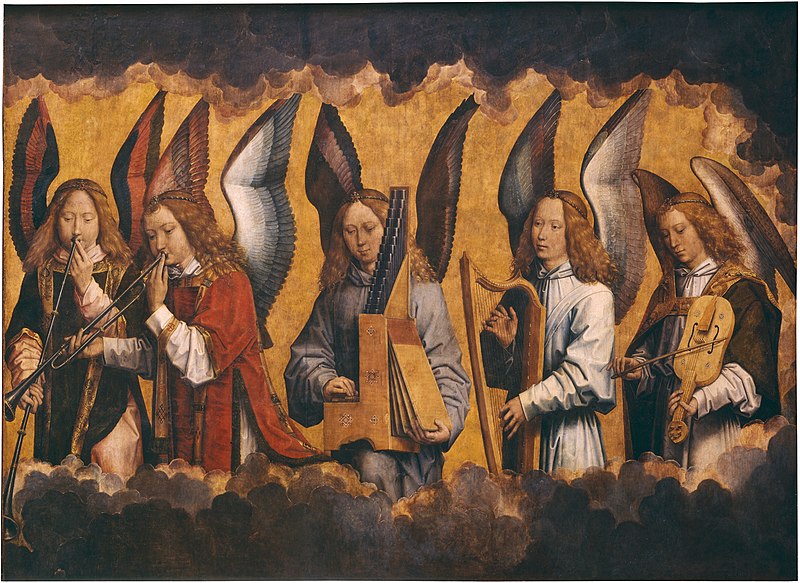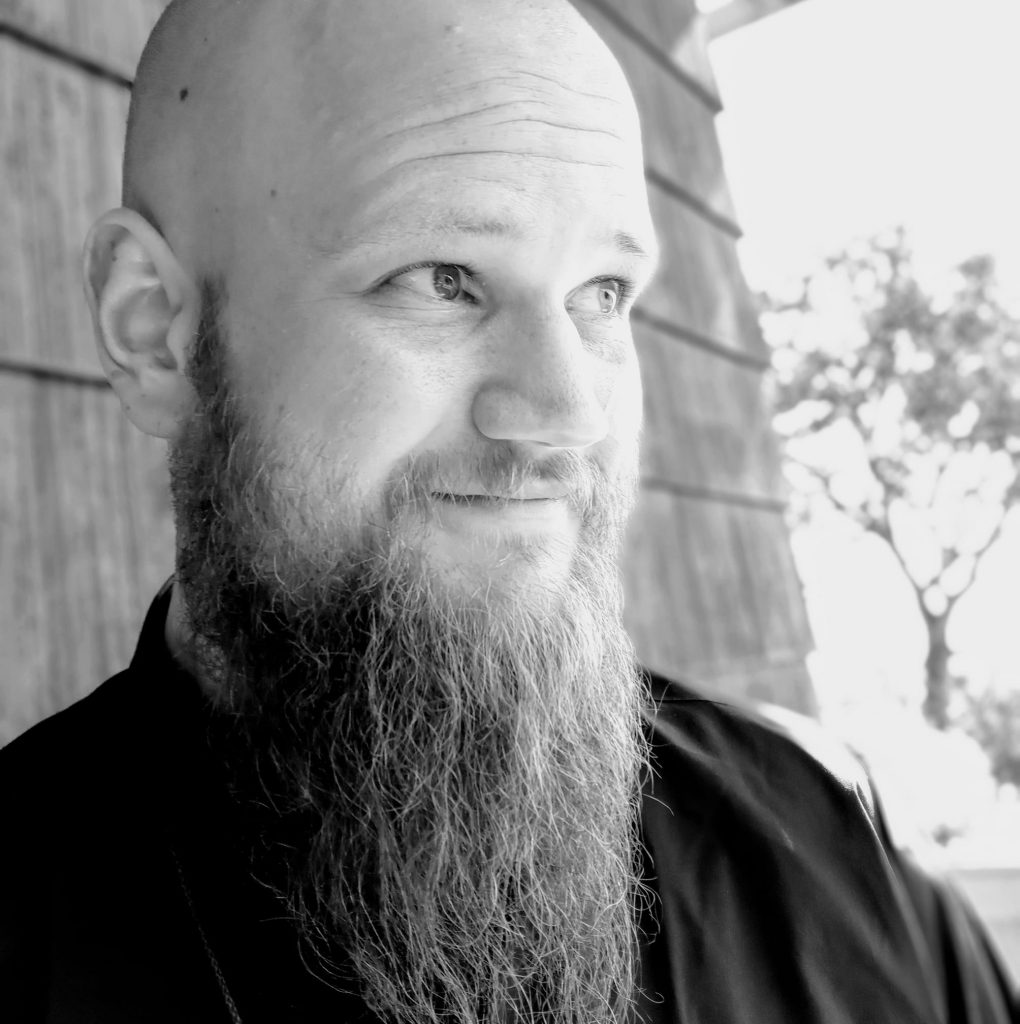Rev. Thom Muller

Angels exist throughout cultures. In many traditions, including much of Christianity, angels are a kind of special species of being, often a messenger or herald of the divine. According to Emanuel Swedenborg’s spiritual system, all angels are human beings. All of us are primarily spirits clothes with temporary material bodies, and continue to be spirits after physical death.
Something very important to bear in mind when talking about Swedenborgian Angelology is this: We cannot think of this as linear time-and-space bound concepts.
Swedenborg adheres to a Neoplatonic cosmology. God is at the center, surrounded by emanations of celestial realms consisting of countless spiritual communities, self-arranged by their individual and communal affections and ideas. It’s an incredibly vast, multi-facetted domain. It is much more real and more tangible than what we are used to on earth. There are countless countries, cities, forests, all corresponding to different spiritual states. People have extremely extensive lives, people have families, sexual partners, friendships, religions etc. In fact people of all religious backgrounds who have lived loving and truthful lives based on their personal understanding are represented there.
This is not something that exists in some far away real that awaits us when we die. Rather it is a dynamic cosmological arrangement that is present right here, right now. We cannot begin to grasp this without the concept of emanationism. Reality, based on Swedenborg, consists of the ultimate source and center, the divine, which is the only thing that is of true substance. Emanating from that center are countless series of states or realities, the closer they are to the center, the more illuminated they are. The further out you get, the more coarse and distinct things get. We, as emanations of light who appear to themselves as being separate and autonomous, navigate these realms. And we can navigate them as we wish. The more we situate our spiritual self towards the center, which is love and wisdom, the two essential qualities of the divine, the more closely united we are to each other and that source and center itself. The more we situate our spiritual self towards selfishness and illusion, aka evil and falsity, the more distant realms we inhabit.
Again, this isn’t some abstract idea about the “after-life”. This is happening right now as we speak. We are inhabiting these realms right now, we just tend to be preoccupied in our attention to the physical plane. The cosmology I described does not exist in some far away realm, but within us.
It can never be said that heaven is outside anyone. It is within; because every angel accepts the heaven that is outside in keeping with the heaven that is within. –Heaven and Hell §54 (1)
Our spiritual selves are right now in the spiritual world, in the company of other spiritual beings. And how this relates to life after “death” is simply that when our physical vessels expire, we continue to live in those realms, and we make a kind of home in the spiritual states we are drawn to. There is no reward or punishment involved in this, those are primitive human concepts. It’s all based on agency and self-realization. We simply end up hanging out where we’re most comfortable, where we feel most at home.
The difference between what Swedenborg calls “heavenly” and “hellish” states is simply that heavenly states are centered around love and truth, and thus closer to the source thereof, and hellish states are states we voluntarily inhabit, which are centered around selfishness and falsity, and thus further towards the periphery, in a self-induced state of willful ignorance.
Now, the obvious question is, does this matter, and if so, why and how. Here’s an important reminder: Beliefs, in this system, are not salvific.
One way of interpreting these texts is the purely metaphysical. Ever since Swedenborg published his theological works, many folks have found that this framework makes sense. And the whole “afterlife” business is definitely where the name Swedenborg has been most prominent, from Spiritualism to the surge of interest Near Death Experiences. People find that a lot of his reports of his travels to the world beyond coincide with those of others, be they ancient texts such as the Tibetan Book of the Dead, the experiences of other mystics and inner teachers, the reports of folks having NDE’s or other altered states of consciousness, such as psychedelic experiences, vision quests, deep meditation, and so on. Others embrace the metaphysics of Swedenborg’s cosmology because they resonate with how they engage philosophical or theological ideas, such as the meaning of existence, an unconditionally loving god, the role of Jesus Christ in the history of Earth, the variety and diversity of religion, etc.
On the metaphysical level, some of the primary conclusions are:
We are all designed to be Angels, and to live forever in a state of love, joy and pleasure.
When our body dies, our consciousness continues and will exist in spiritual states that correspond to our affections and inner desires.
–We will live in loving community with people who share varieties of those same affections.
–We get to be reunited with loved ones, if we want to.
–We get to have a rich love life, based on true mutual affection and attraction and agency.
–All religions can get you there, the recipe is simple: Be as loving and as truthful as you can. As long as your tradition gets you to that point, it is part of God’s universal church.
–We are constantly in the presence of angels, who never compel or compromise our agency, but gently inspire us with goodness and truth that emanates directly from the divine.
–The universe is ultimately a benevolent place, and the source of creation, the center and substance of all that is, is unconditional love, transcendent wisdom, and the desire to be one with creation.
I want to believe this. And I’m quite convinced that Swedenborg did experience what he claims he experienced. But there is also skeptical side within me, especially when it comes to the metaphysics of this system.
Swedenborgians, meaning avid readers of Swedenborg, have fallen all over the spectrum between embracing this as literal metaphysical reality and completely psychologizing these experiences. We all likely find ourselves somewhere within that spectrum.
This is a good thing! There is, indeed, more than meets the “surface”. According to Swedenborg, there are multiple layers of meaning to this (notice again how important layers and levels are). One is the metaphysical, and he himself really did believe this stuff was “literally” going on. Yet, because of how the spiritual world is structured, there is a deeper and more profound layer in which everything he is seeing in the spiritual world consists of spatio-temporal images which are NOT IN SPACE IN TIME. The whole concept of linear time and set space do not exist in the spiritual world. It only exists to the degree to which it represents states.
In other words, as he is going within, into the more subtle and yet more real realms of the spiritual world which exists of spirit and not of matter, and outside of time and space, he is seeing spiritual realities manifested by means of images which he, in his natural, earthly mind, can process.
He’s very clear about this. It is the outmost, the natural level, on which time and space truly matter, or at least appear to matter. And it is from that level from which we ask such questions as “where will I BE after I DIE? What will it feel like? What will I look like?” Those are all extremely relevant questions. But the inner self, our true spiritual self, isn’t really that concerned with linear time and set space, and exists beyond it.
An illustration might be helpful:
Swedenborg has visions of angels in the highest heavens being completely naked. On the literal level, we might conclude from this that there is a place in the highest heaven where people are nudists. And we may or may not be drawn to this as a literal place to hang out. At the same time, Swedenborg makes it very clear that the meaning of this nakedness is spiritual, and represents a spiritual state of innocence and purity and unashamed-ness.
When we read this, we are invited to meditate on what that then really means for us in a concrete way. What is my inner highest heaven, and do my angelic feelings and emotions enjoy a state of complete purity and unashamed, intimate at-home-ness in that realm? When we read his descriptions of scenes and characters in the countless spiritual realms he visits, are we able to view them not simply as a logbook of the afterlife (which they claim to be) but as a logbook of our own inner world (which they also claim to be!). A collective unconscious that exists and unites us and our source on a level far more subtle and yet far more real than this ego-based earthly experience…
What if these spiritual realities, these spiritual dynamics, these spiritual laws, are in fact universal realities we are constantly engaging on more subtle levels of our spiritual psyche? States that exist now and are real and tangible?
We can inhabit the state of the angelic community of Michael, now. We can enter heavenly states and cultivate them, make them our home, grow more deeply into unitive relationship with God and with each other.
Swedenborg believed both of those levels applied to his writings. And very importantly, the inner always trumps the outer. The outer is important, just like everything in time and space that concerns us as people is important. But the inner sense does not depend on the outer sense.
This is an invitation to both ponder the questions about the afterlife which Swedenborg’s reports evoke, with a healthy dose of skepticism and agency. Further, it is an invitation to consider these things from an inner perspective. How do these dynamics affect me NOW, and how can I make my inner life more heavenly, more love oriented?
As the writer Lon Milo Duquette puts it: “It’s all in your head, you just have no idea how big your head is.” (2)
(1) Swedenborg, Emanuel. Heaven and Hell. Translated by George F. Dole. West Chester: Swedenborg Foundation, 2000.
(2) DuQuette, Lon Milo. Low Magick. United States: Llewellyn Worldwide, Limited, 2011.
Image: Christ Surrounded by Singing and Music Making Angels. Hans Memling. c. 1483. Antwerp Museum of Fine Arts

Rev. Thom Muller is pastor at the Swedenborgian Society of the East Bay at Hillside, an Urban Sanctuary, in El Cerrito, CA, as well as senior editor of Our Daily Bread. His passions include the intersection of spirituality and psychology, interfaith theology, and the Western esoteric tradition. A native of Germany, Rev. Muller was ordained into the ministry of the Swedenborgian Church of North America in 2016, upon receiving his theological education at Bryn Athyn College and the Pacific School of Religion in Berkeley, CA.